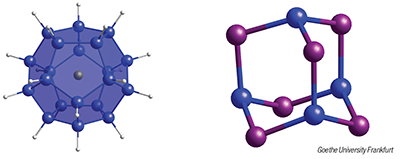The latest generations of computer chips are only a few nanometers in size and are becoming ever more energy-saving and powerful as a result of progressive miniaturization. Since the etching processes traditionally used in chip production are increasingly reaching their limits, the development of new, nanostructured semiconductor materials is essential. Such nanoscale semiconductors also play a central role in converting electricity into light and vice versa.
With these goals in sight, a team at Goethe University Frankfurt (Frankfurt am Main, Germany; www.goethe-university-frankfurt.de), led by professor Matthias Wagner, has succeeded in synthesizing molecular nano-scale spheres made of 20 silicon atoms, dubbed silafulleranes, with the formula (Cl@Si20H20) 1–. The 20 silicon atoms (blue) of silafullerane form a dodecahedron, a body composed of regular pentagons (diagram, left), and encapsulates a chloride ion (green). The hydrogen atoms (grey) that protrude outward at each silicon corner of the body can be replaced with functional groups to give the compound different properties.
The second new class of materials are crystalline building blocks made of 10 silicon (blue) and germanium (magenta) atoms that have a diamond-like structure (diagram, right). The silicon-germanium alloy has the potential to form “faultless” nanodiamond-like crystals, with possible applications in pharmaceutical and catalyst research.

Insights into the electronic structures of the new compounds were provided by computer-based theoretical analyses from professor Stefan Grimme’s research group at the University of Bonn (Germany; www.chemie.uni-bonn.de). The two new classes of materials have potential applications in the miniaturization of computer chips, in high-resolution screens for smartphones, and in solar cells and light-emitting diodes with the highest levels of efficiency.